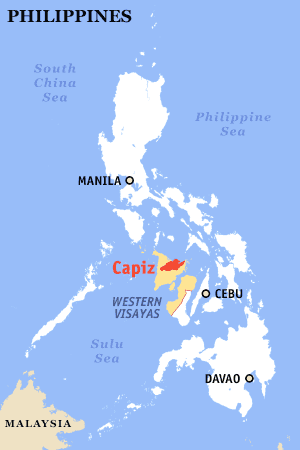Capiz
|
|
Capiz is a province of the Philippines located in the Western Visayas region. Its capital is Roxas City and is located at the northeastern portion of Panay island, bordering Aklan and Antique to the west, and Iloilo to the south. Capiz faces the Sibuyan Sea to the north. Capiz is known for its mother-of-pearl shells that have the same name and are used for decoration, making lampshades, trays, window doors, etc..
Ph_seal_capiz.png
Image:Ph_seal_capiz.png
2000 census—654,156 (36th largest)
Density—248 per km² (28th highest)
Highly urbanized cities—0
Component cities—1
Municipalities—16
Barangays—473
Congressional districts—2

| Contents |
People and Culture
Aswang
Among Filipinos, Capiz is subject or focus of many Aswang, and other types of mythylogical ghost, goblins, ghouls and manananggal and other monster stories. Capiz is ( unfairly ) rumored to have a number of aswang and covens of witches. Superstitious folk who believe in their existence can still be found in these parts. They typically adorn windows, rooms, etc. with garlic bulbs, holy water, etc..
Myths, Folklore, Superstitious Beliefs and Practices
The early Panayanon believed in many gods. Bulalakaw, a bird which looked like a peacock and could cause illness, was said to live in the island's sacred mountain called Madya-as. A chief goddess was believed to reside in the mountain of the nearby island of Negros Occidental. She was called Laon, after whom Mt. Kanlaon is named. Mediators to the gods, also said to be the first priests, were: Bangutbanwa, who prayed for good harvests and an orderly universe; Mangindalon, who interceded for sick persons and prayed for the punishment of enemies; and Soliran and Solian, who performed marriage ceremonies. Manunubo was the good spirit of the sea.
The kama-kama are dwarves living in earth mounds, and are lazy and fun loving. The tamawu/taglugar are spirits that can be either friendly or evil. They live in resplendent palaces that look like mere boulders to the human eye. When they find a human being attractive, they entice the person to join them; this peculiar act of courtship is called yanggaw. The dwindi is a dwarf residing in a mount of earth. The lulid sa bangsud has a big head, but a small torso and limbs. One who disturbs the mound where it resides falls ill. The agta is a very dark, hairy person living in the forest. Although a trickster, it is helpful to people. The amamanhig is a dead person who has returned to life and simple echoes everything that mortals say; it has lost the power to think. Hiwit or barang is a ritual that gives one of the power to inflict pain on an enemy.
Economy
Geography
Political
Capiz is subdivided into 16 municipalities and 1 city.
City
Municipalities
Physical
History
Folk history recorded in the Maragtas by Pedro Monteclaro says ten Bornean datus landed at a site now known as San Joaquin town in Iloilo province. They purchased Panay from the Aeta, cultivated the land, and renamed the island Madya-as. They divided it into three communities: Irong-irong, Akean (which includes the Capiz area), and Hamtik.
It is said that in Capiz in 1570, the Datu Bankaya’s wife of the Aklan district gave birth to twin daughters. Twin is "Kapid" in the local dialect, so the Spaniards adopted the name Capiz (Kapid) as inadvertently miscommunicated to them by the natives.
Capiz, which was part of Aklan in pre-Spanish times, was one of the early settlements of the Malayas, centuries before the coming of the Spaniards to the Philippines. It was part of the Confederation of Madjaas, formed after the purchase of Panay by the Bornean datus from the Negrito king named Marikudo.
When the Spaniards led by Miguel Lopez de Legazpi came to Panay from Cebu in 1569, they found people with tattoos, and so they called it Isla de los Pintados. How the island itself came to be called Panay is uncertain. The Aeta called it Aninipay, after a plant that abounded in the island. Legend has it that Legazpi and his men, in search of food, exclaimed upon the island, pan hay en esta isla!. So they established their first settlement in the island at the mouth of the Banica River in Capiz and called it Pan-ay. This was the second Spanish settlement in the Philippines, the first being San Miguel, Cebu.
| Regions and Provinces of Visayas | |
| Western Visayas: | Aklan | Antique | Capiz | Guimaras | Iloilo | Negros Occidental |
| Central Visayas: | Bohol | Cebu | Negros Oriental | Siquijor |
| Eastern Visayas: | Biliran | Eastern Samar | Leyte | Northern Samar | Samar | Southern Leyte |
